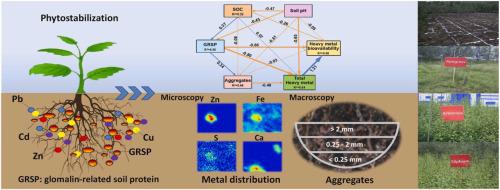Journal of Hazardous Materials ( IF 13.6 ) Pub Date : 2022-06-22 , DOI: 10.1016/j.jhazmat.2022.129445 Hansong Chen 1 , Juan Xiong 2 , Linchuan Fang 3 , Fu Han 4 , Xiaolan Zhao 5 , Qiaohui Fan 5 , Wenfeng Tan 6

|
Glomalin-related soil protein (GRSP) is an essential bioactive component that may respond to heavy metal stress; however, its exact influence on metal bioavailability and the associated mechanism remains poorly understood. This study investigated the speciation and distribution of heavy metals in soil aggregates associated with GRSP through macroscopic and microscopic approaches. A field study showed that the metal ions were distributed to the macro-aggregate fraction by partitioning the particle size classes during phytoremediation. Partial least squares path modeling (PLS-PM) demonstrated that the heavy metal bioavailability was negatively affected by aggregate stability (61.5%) and GRSP content (52.8%), suggesting that the soil aggregate properties regarding GRSP were vital drivers in mitigating environmental risk closely associated with toxic metal migration in soil–plant systems. The nonideal competitive adsorption (NICA)-Donnan model fitting suggested that GRSP were rich in acid site density, and the complexation with deprotonated groups dominated the speciation of heavy metals in soil. Further, the microfocus X-ray absorption/fluorescence spectroscopy analysis indicated that GRSP might promote the formation of stable metal species by binding with sulfur-containing sites. This study highlights the role of GRSP in heavy metal sequestration in contaminated soils, providing new guidance on the GRSP intervention for phytoremediation strategies.
中文翻译:

格洛马林相关土壤蛋白诱导土壤团聚体中重金属的螯合:为期五年的植物修复实地研究
Glomalin 相关土壤蛋白 (GRSP) 是一种重要的生物活性成分,可应对重金属胁迫;然而,它对金属生物利用度和相关机制的确切影响仍然知之甚少。本研究通过宏观和微观方法研究了与 GRSP 相关的土壤团聚体中重金属的形态和分布。一项实地研究表明,金属离子通过在植物修复过程中划分粒径类别而分布到宏观聚集体部分。偏最小二乘路径模型 (PLS-PM) 表明,重金属生物利用度受到聚集体稳定性 (61.5%) 和 GRSP 含量 (52.8%) 的负面影响,表明关于 GRSP 的土壤团聚体特性是减轻与土壤-植物系统中有毒金属迁移密切相关的环境风险的重要驱动因素。非理想竞争吸附(NICA)-Donnan模型拟合表明GRSP具有丰富的酸性位点密度,与去质子化基团的络合主导了土壤中重金属的形态。此外,微焦点 X 射线吸收/荧光光谱分析表明,GRSP 可能通过与含硫位点结合来促进稳定金属物种的形成。本研究强调了 GRSP 在污染土壤中重金属封存中的作用,为 GRSP 干预植物修复策略提供了新的指导。非理想竞争吸附(NICA)-Donnan模型拟合表明GRSP具有丰富的酸性位点密度,与去质子化基团的络合主导了土壤中重金属的形态。此外,微焦点 X 射线吸收/荧光光谱分析表明,GRSP 可能通过与含硫位点结合来促进稳定金属物种的形成。本研究强调了 GRSP 在污染土壤中重金属封存中的作用,为 GRSP 干预植物修复策略提供了新的指导。非理想竞争吸附(NICA)-Donnan模型拟合表明GRSP具有丰富的酸性位点密度,与去质子化基团的络合主导了土壤中重金属的形态。此外,微焦点 X 射线吸收/荧光光谱分析表明,GRSP 可能通过与含硫位点结合来促进稳定金属物种的形成。本研究强调了 GRSP 在污染土壤中重金属封存中的作用,为 GRSP 干预植物修复策略提供了新的指导。微焦点X射线吸收/荧光光谱分析表明,GRSP可能通过与含硫位点结合促进稳定金属物种的形成。本研究强调了 GRSP 在污染土壤中重金属封存中的作用,为 GRSP 干预植物修复策略提供了新的指导。微焦点X射线吸收/荧光光谱分析表明,GRSP可能通过与含硫位点结合促进稳定金属物种的形成。本研究强调了 GRSP 在污染土壤中重金属封存中的作用,为 GRSP 干预植物修复策略提供了新的指导。


























 京公网安备 11010802027423号
京公网安备 11010802027423号